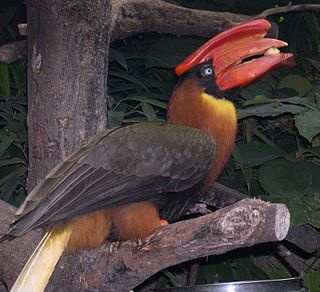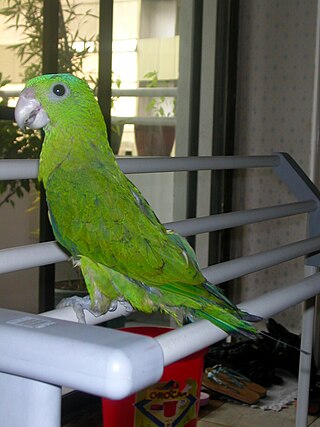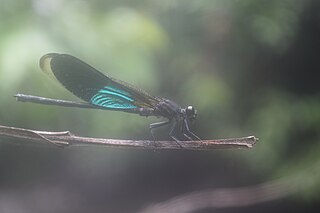
The Luzon bleeding-heart or punay is one of a number of species of ground dove in the genus Gallicolumba that are called "bleeding-hearts". The native name in Tagalog is punay. It is also known as paloma de punalada 'stabbed pigeon'. The Luzon Bleeding-heart is the species in which the "blood" feature is most pronounced, with the reddish hue extending down the belly, furthering the illusion of blood having run down the bird's breast.

The Philippine tarsier, known locally as mawumag in Cebuano and other Visayan languages, and magô in Waray, is a species of tarsier endemic to the Philippines. It is found in the southeastern part of the archipelago, particularly on the islands of Bohol, Samar and Leyte. It is a member of the approximately 45-million-year-old family Tarsiidae, whose name is derived from its elongated "tarsus" or ankle bone. Formerly a member of the genus Tarsius, it is now listed as the only member of the genus Carlito, a new genus named after the conservationist Carlito Pizarras.

The Mindoro bleeding-heart, also referred to as kulo-kulo, la-do, manatad, manuk-manuk, punay, and puñalada by the Mangyan, is a species of ground dove native solely to the island of Mindoro in the Philippines. It is critically endangered and threatened by habitat loss largely motivated by marble extraction. Due to its biological line and its survival status, it has been listed as an EDGE species by the Zoological Society of London.

The Negros bleeding-heart pigeon is endemic to the Philippines where it is found on the islands of Negros and Panay. It is critically endangered; continuing rates of forest loss on the two islands where it occurs suggest that it will continue to decline. The population is estimated to be just 50 - 249 mature individuals. The species has an extremely small, severely fragmented population. The bird is listed as an EDGE species under the analysis of the Zoological Society of London.

Gallicolumba is a mid-sized genus of ground-dwelling doves which occur in rainforests on the Philippines. Local name 'punay' which is a general term for pigeons and doves. They are not closely related to the American ground doves. Rather, the present genus is closest to the thick-billed ground pigeon.

The rufous hornbill, also known as the Philippine hornbill and locally as kalaw, is a large species of hornbill endemic to the Philippines. The are referred by locals as the "clock-of-the-mountains" due to its large booming call which typically occur of every hour. It occurs in moist tropical lowland forest. They are now considered to be a threatened species and its reasons for decline being habitat destruction, hunting and poaching for the illegal pet trade.

The Sulu bleeding-heart is a species of bird in the pigeon and dove family, Columbidae. It is endemic to the island of Tawi-Tawi and its surrounding islets in the Philippines' Sulu Archipelago. This species is known only from two specimens collected in 1891, and has not been recorded with certainty since. It lives in primary and secondary forests that have a closed canopy. The Sulu bleeding-heart is a medium-sized pigeon with a short tail. Bright metallic green feathers stretch from the forehead and crown down to the mantle and sides of the breast, where they surround a large, pale orange breast spot with diffuse edges that gives the species the name "bleeding-heart". The lower wings and back are varying shades of brown, and the throat and chest are largely white. The belly is an ashy-gray.

The blue-crowned racket-tail is a parrot found on all the larger islands of the Philippines except Palawan and Panay islands. It is 27 cm, basically green with a blue crown, bluish undertail, whitish beak, and dark underwings with green coverts. The blue-headed racket-tail was formerly included in this species.

The yellow-wattled bulbul is a species of songbird in the bulbul family of passerine birds. It is endemic to the Philippines.

The giant scops owl, lesser eagle-owl or the Mindanao eagle-owl, is a species of owl in the family Strigidae. It is endemic to the Philippines. In size and structure, it is considered intermediate between a scops owl and an eagle-owl. Its natural habitat is tropical moist lowland forests. It is threatened by habitat loss.

The amethyst brown dove is a species of bird in the family Columbidae.

The yellow-breasted fruit dove locally known as balorinay is a species of bird in the family Columbidae. It is endemic to the Philippines. Its natural habitat is tropical moist lowland forest. While it is listed as least concern in IUCN, it is declining due to habitat loss, hunting, and trapping for the illegal wildlife trade.

The black-bibbed cicadabird or black-bibbed cuckooshrike is a species of bird in the family Campephagidae. It is endemic to the Philippines. The species is elusive and poorly known.

The Visayan broadbill is a species of bird in the family Eurylaimidae where it was previously conspecific with the wattled broadbill. It is endemic to the islands of Samar, Leyte and Bohol in the central Philippines. Its natural habitat is tropical moist lowland forests. It is threatened by habitat loss.

The wattled broadbill or Mindanao broadbill is a species of bird in the family Eurylaimidae where it was previously conspecific to the Visayan broadbill. It It is endemic to the islands of Mindanao, Basilan, Dinagat and Siargao in the Philippines. It is one of the most striking birds in the country with its sky-blue wattle and bill and yellow wing patch Its natural habitats are tropical moist lowland forest, tropical mangrove forest, and tropical moist shrubland. It is threatened by habitat loss.

The Philippine oriole or grey-throated oriole is a species of bird in the family Oriolidae. It is endemic to the Philippines.

The azure-breasted pitta is a species of bird in the family Pittidae. It is a striking and colorful bird having colors of red, azure, green, black and white, It is endemic to the islands of Mindanao, Bohol, Leyte and Samar in the Philippines. Its natural habitat is tropical moist lowland forest. It is threatened by habitat loss.

Pulchrana grandocula, also known as the big-eyed frog, is a species of "true frog", family Ranidae. It is endemic to the southern Philippines and occurs on the islands of Basilan, Bohol, Camiguin Sur, Dinagat, Samar, Siargao, Bucas Grande, and Mindanao. Some populations from Mindanao formerly assigned to this species are now recognized as a separate species, Pulchrana guttmani.

Euphaea amphicyana is a species of damselfly that is endemic to the Philippines. This species prefers open spaces in forested clear flowing streams, creeks and rivers. E. amphicyana seems to tolerate moderate human disturbance as long as vegetations and clear running water is maintained. Unfortunately, heavy deforestation and human settlement is occurring within its range and these are a threat to the species.





















